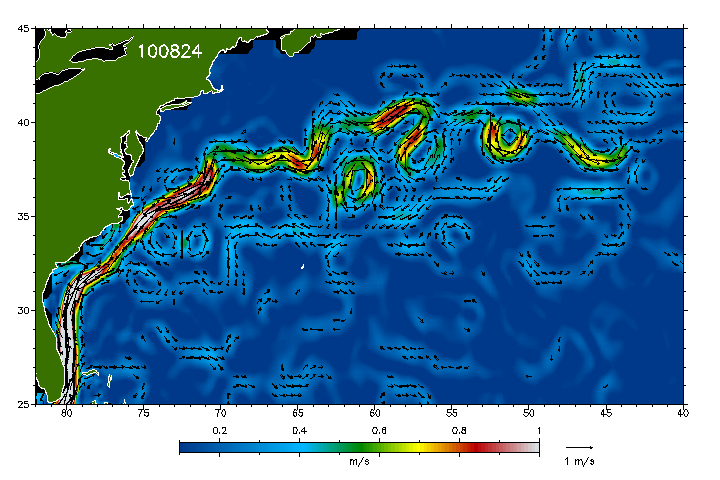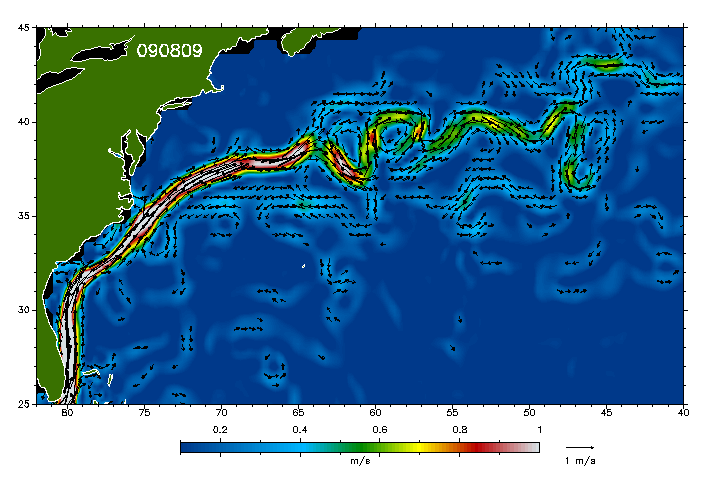BP oil spill driving us into an ice age?
I don't buy it
(See comments from readers at end)
5 Sep 10 - Okay, enough already. People keep sending me stories saying that the BP oil spill is driving us into an ice age.
With the Gulf Stream and North Atlantic Current supposedly dying, and with the Gulf of Mexico loop current supposedly already dead, the stories insist that our planet is now experiencing a real life version of the movie "The Day After Tomorrow."
"Record breaking heat and drought in Russia," the stories say. "Heat and flooding in large parts of Asia. Killing cold temperatures in South America. All brought on by the large amounts of oil discharged into the Gulf of Mexico by the BP Oil Disaster."
Why haven’t I posted those stories?
Because I think they are wrong. As much as I believe that we are in fact headed into an ice, I don’t believe the oil spill has anything to do with it.
Gulf loop current collapse not unusual
The fact is that the Gulf loop current collapse is not all that unusual. "There is a well- known history of the gulf loop current 'collapsing'," says reader Dennis Waggener. "This happened three times in 1996. It is a common event and not at all unusual."
"Satellite images in the past several weeks are showing that the Gulf Loop Current is broken and may cease to function entirely!" the stories yell. "This will result in massive climate change and possibly an ice age for Europe!"
The Loop Current begins in the Caribbean, flows around the Yucatan Peninsula and into the Gulf of Mexico, then loops around the Gulf and exits on the east side and runs between Cuba and Florida into the Atlantic where it eventually contributes to the Gulf Stream.
One article from SOTT contains an audio with a very reasonable-sounding voice telling us that "I don't want to be a fearmonger, but..."
That's like when your wife says, "I don't mean to complain, but..." And then goes ahead and complains. She just doesn't want you to notice that she’s complaining.
The voice reminds us that this is "all hard-science data" and not from "conspiracy theorists," pointing out that the information comes from the Italian Institute for Nuclear Physics and the Colorado Center for Astrodynamic Research at the University of Colorado, Boulder.
The Loop Current keeps Europe relatively warm and livable, not buried beneath three miles of ice as happened to much of the American Midwest during the last ice age, says the voice.
"It is a fact is that ice ages have existed." the audio continues. Scientists suspect that the tipping point comes when the global conveyor belt (the Loop Current) stops functioning. The transition period is often very abrupt, within a couple of years. (I agree that the transition can be very abrupt.)
The loop current has broken, the audio continues. This is "unprecedented." It may be a temporary phenomenon, or it may be permanent. It may cause irreparable damage, and it may be caused by millions and millions of gallons of oil pouring into the gulf. It may generate a chain reaction of unpredictable critical phenomena and instabilities. It may have serious consequences." (Did you notice how many times they used the word "may"?)
"What it portends is ... in other words... ICE AGE !! No joke."
The stories are based on theories put forth by theoretical physicist, Dr. Gianluigi Zangari of the National Institute of Nuclear Physics (INFN) in Italy. Dr. Zangari thinks the massive amount of oil from the BP Oil Disaster has resulted in a dramatic weakening in the vorticity of the Gulf Stream and North Atlantic Current, and a reduction in North Atlantic water temperatures of 10C.
It is a university level physics experiment to use a tub of cool water and inject a colored stream of warm water into it, the stories say. You can see the boundary layers of the stream. If you add oil to the tub it breaks down the boundary layers and effectively destroys the current vorticity. This is what is happening (supposedly) in the Gulf of Mexico and the Atlantic Ocean.
The entire 'river of warm water' that flows from the Caribbean to the edges of Western Europe is (supposedly) dying due to the approximately two million gallons of Corexit that BP used to hide the scale of oil spill. The Corexit, plus several million gallons of other dispersants, have (supposedly) caused the over two hundred million gallons of crude oil that gushed from the BP wellhead to mostly sink to the bottom of the ocean.
There are several names to the themoregulation 'river of warm water' that keeps the Northern Hemisphere from going into a new Ice Age.
Once the Loop Current leaves the Keys, it flows up the East Coast of America (Florida, Georgia, South Carolina, and part of North Carolina) to the Outer Banks. At the Outer Banks the current heads east into the North Atlantic where it is known as the Gulf Stream. Eventually the Gulf Stream becomes the North Atlantic Current, which itself eventually becomes the Norway Current and the Canary Current.
This 'river of warm water' is part of a much larger system that includes the Atlantic South Equatorial Current, which flows north along the coast of Brazil (the North Brazil Current), where it becomes the Caribbean Current, then is renamed the Yucatan Current as it flows north into the Yucatan Channel. This entire system is one of the main global themoregulation processes that regulates the planet's temperatures.
Many of the stories include a graphic from Wikipedia showing the thermohaline circulation, which is sometimes called the ocean conveyor belt, other times called the great ocean conveyor, or the global conveyor belt.
Now let me ask you. How can this current possibly stop? It is caused by the rotation of the earth. Unless the BP oil spill can make our planet stop turning on its axis (we’re rotating at the rate of 1,000 miles per hour), that current will continue to be generated.
Simply explained, the earth rotates counter-clockwise, pushing the water of the South Atlantic westward against Central and South America where it splits into two streams - the Brazil Current, flowing south, and the Gulf Stream, flowing north, the Gulf Stream being greater of the two.
I see no way that that current will cease moving. Intentionally or not, these oil-spill stories become just another way to blame humans for something that is not our fault.
And as I said, this has happened before.
George Born and Robert Leben of the University of Colorado used data from satellites TOPEX/POSEIDON and ERS-2 to track the location of the Loop Current, and to monitor the anticyclonic eddies that periodically separate from its northward intrusions into the eastern Gulf of Mexico.
They found that the Loop Current shed a series of three such anticyclonic eddies in 1996. (See http://ocean.tamu.edu/Quarterdeck/QD6.1/spin.html)
Shortly after the oil spill, Dr. Bill Deagle, MD, of The Nutrimedical Report interviewed Dr Zangari concerning the dissolution of the Loop Current, and over the next few weeks began voicing his concerns on LiveStream.com/TheNutriMedicalReportShow.
“A new Ice Age could kill 2/3 of the human race in the first year in a rapid onset,” says Dr. Deagle. “A slower onset would likely kill close to this number but simply take a handful of years.! Thank you BP; thank you President Obama, the lies and the dispersants were just great. Now if you could just direct all that hot air to the right places maybe we can avoid a icy hell in our near future.”
Dr. Deagle has interviewed me several times, and although I have the utmost respect for his brilliance, I just can’t agree with him on this subject. Regardless of how much oil is pumped into the seas, our planet is going to keep on turning.
So, to sum up. Are we headed into an ice age? Yes, I think we are.
But should we blame BP? Absolutely not.
Humans don’t cause global warming, and humans don’t cause ice ages. They're simply parts of a naturally occurring cycle - three natural cycles actually - the sunspot cycle, the Milankovitch cycle, and a third cycle known as orbital stretch.
Instead of trying to "stop global warming," or "stop the ice age," we'd be a lot better off looking for ways to cope with the inevitable.




